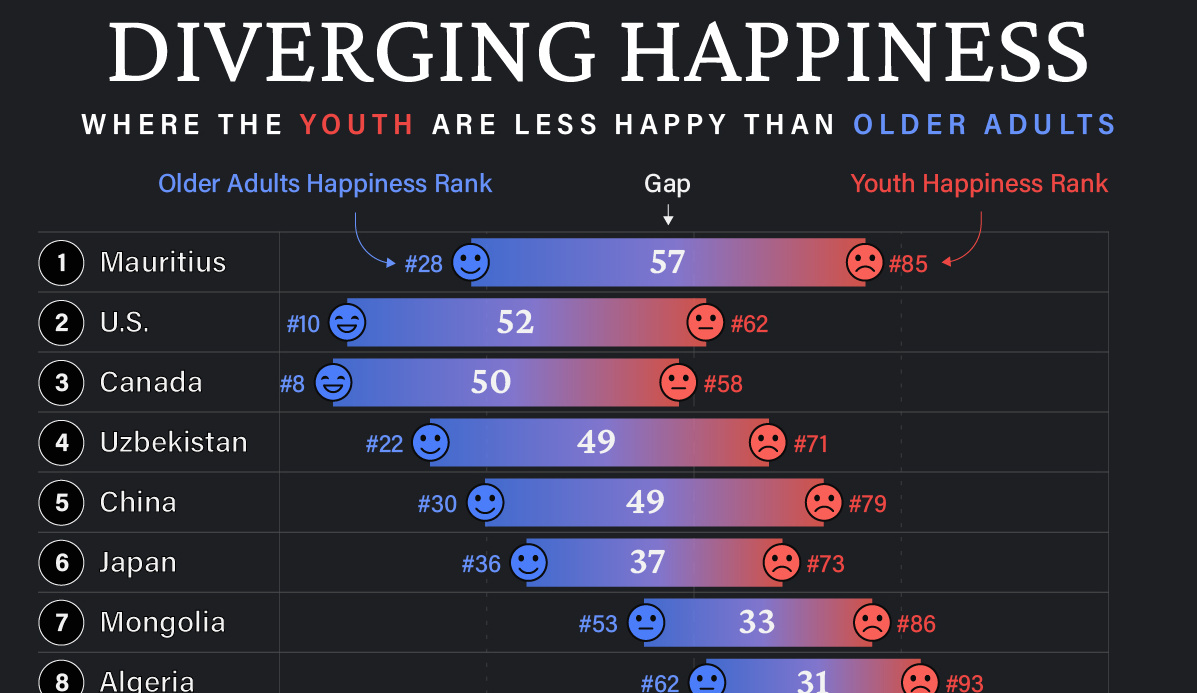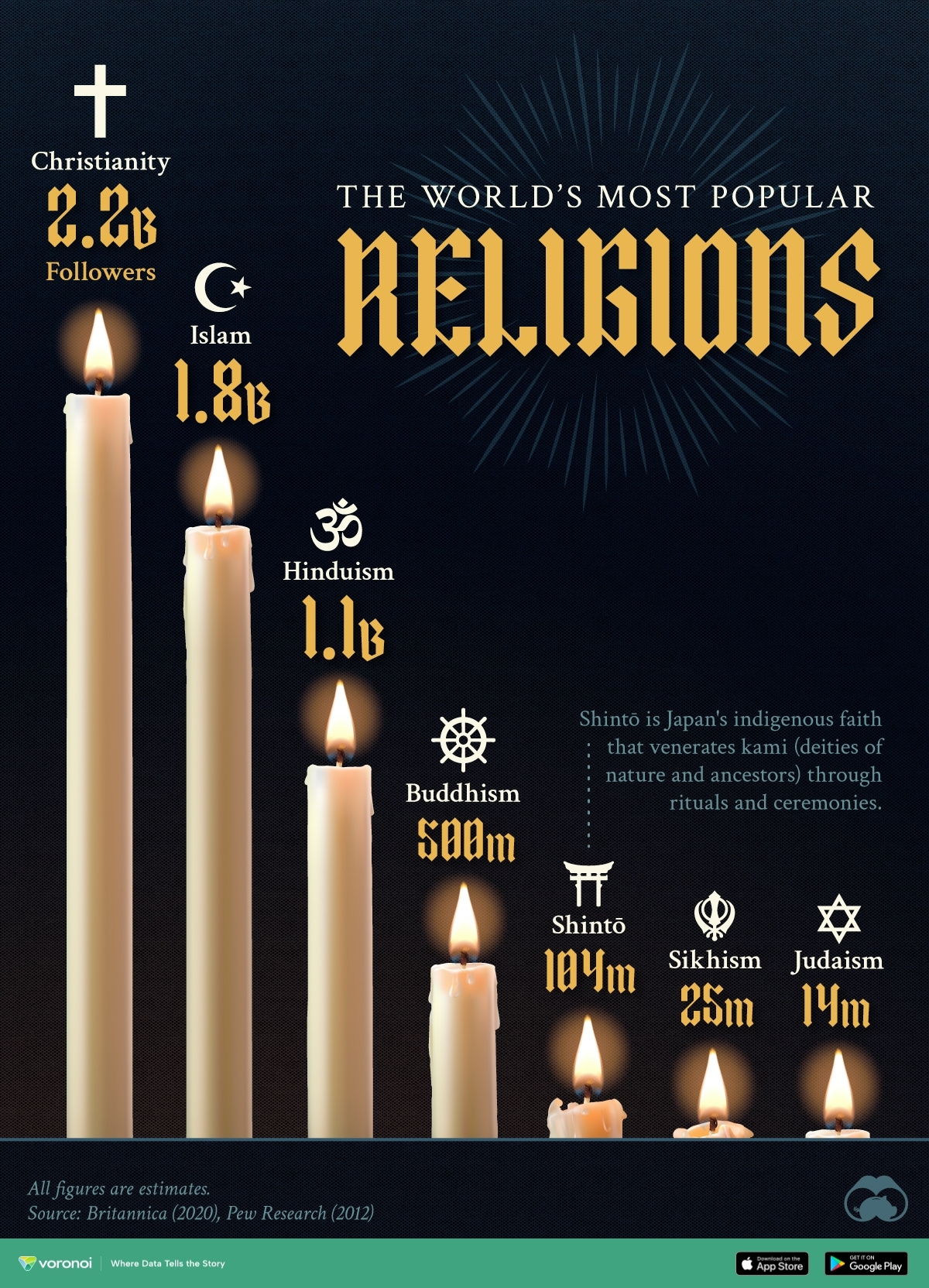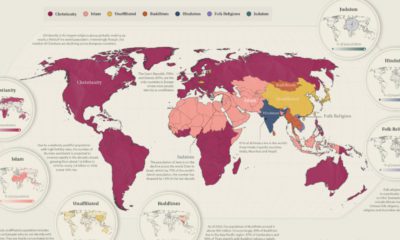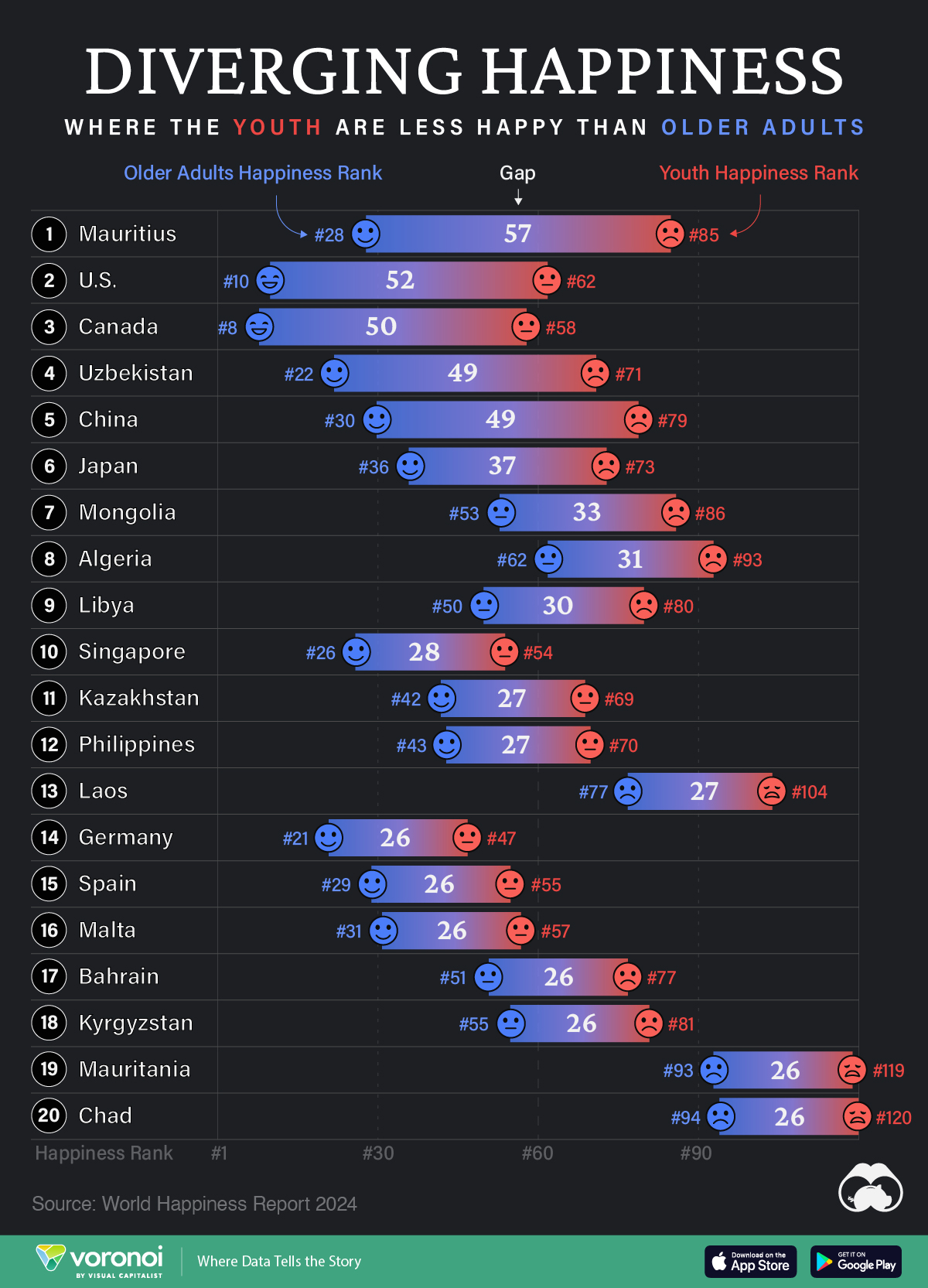Culture
The World’s Most Popular Religions
![]() See this visualization first on the Voronoi app.
See this visualization first on the Voronoi app.
The World’s Most Popular Religions
This was originally posted on our Voronoi app. Download the app for free on iOS or Android and discover incredible data-driven charts from a variety of trusted sources.
Religion has played a pivotal role in shaping the beliefs, values, and cultures of societies around the world.
While estimating the exact number of followers for each faith poses a considerable challenge, figures from reputable sources like Britannica and Pew Research provide valuable insights into the global religious landscape.
The Religions With the Most Followers
Below are the seven most popular religions, based on Britannica’s analysis and estimates:
| Rank | Religion | Estimated number of followers |
|---|---|---|
| 1 | Christianity | 2,200,000,000 |
| 2 | Islam | 1,800,000,000 |
| 3 | Hinduism | 1,100,000,000 |
| 4 | Buddhism | 500,000,000 |
| 5 | Shinto | 104,000,000 |
| 6 | Sikhism | 25,000,000 |
| 7 | Judaism | 14,000,000 |
Note: These estimates provide a broad perspective on the distribution of followers for each religion, recognizing the inherent difficulty in accurately counting global adherents.
There are three major religions with over 1 billion followers: Christianity, Islam, and Hinduism.
Buddhism is also a big player, with 500 million followers worldwide. After this, there’s a significant dropoff, with the next three largest religions (Shintō, Sikhism, and Judaism) adding up to fewer than 150 million followers between them.
It’s also worth mentioning that practically speaking, many of these popular religions have various sects, denominations, branches, or interpretations that they can be further grouped into.
For example, Christianity itself can be further categorized into denominations such as Catholic (50.1%), Protestant (36.7%), Eastern Orthodox (9.4%), Oriental Orthodox (2.5%), and other smaller Christian denominations (1.3%).
What Religions Missed the Cut?
Not captured in the above visual are many smaller organized religions, as well as folk and traditional religions, that are distributed all around the world.
Examples of notable religions that did not make the top seven list include: Taoism, Muism, Cao Dai, Baháʼí Faith, Jainism, Tenrikyo, Wicca, and Zoroastrianism.
Meanwhile, hundreds of millions of people also practice African traditional religions, Chinese folk religions, Native American religions, and Australian aboriginal religions.
Demographics
Ranked: Countries Where Youth are the Most Unhappy, Relative to Older Generations
Conventional wisdom says that young adults (those below 30) tend to be the happiest demographic—but this is not true for these countries.

Countries with the Biggest Happiness Gaps Between Generations
This was originally posted on our Voronoi app. Download the app for free on iOS or Android and discover incredible data-driven charts from a variety of trusted sources.
“They say a person needs just three things to be truly happy in this world: someone to love, something to do, and something to hope for.” — Tom Bodett
Measuring happiness is tricky business, more so when taking into account how different regions, cultures, and faiths define it. Nevertheless, the World Happiness Report attempts to distill being happy into a single score out of 10, and then ranks countries by their average score.
We’ve visualized the high-level findings from the latest happiness report in this series of maps. However, the report also dives deeper into other significant trends in the data, such as a growing disparity in happiness between age groups within countries themselves.
In the chart above, we list countries by the biggest gaps in happiness ranks between young adults (<30) and older adults (60+). A higher number indicates a larger gap, and that the youth are far unhappier than their older counterparts.
Where are Youth Unhappier than Older Adults?
Mauritius ranks first on this list, with a massive 57 place gap between older adult and youth happiness. The 1.26 million-inhabited island nation briefly reached high income status in 2020, but the pandemic hit hard, hurting its key tourism sector, and affecting jobs.
The country’s youth unemployment rate spiked to close to 25% that year, but has since been on the decline. Like residents on many similarly-populated islands, the younger demographic often moves abroad in search of more opportunities.
| Rank | Country | Youth Happiness Rank | Older Adult Happiness Rank | Happiness Gap |
|---|---|---|---|---|
| 1 | 🇲🇺 Mauritius | 85 | 28 | 57 |
| 2 | 🇺🇸 U.S. | 62 | 10 | 52 |
| 3 | 🇨🇦 Canada | 58 | 8 | 50 |
| 4 | 🇺🇿 Uzbekistan | 71 | 22 | 49 |
| 5 | 🇨🇳 China | 79 | 30 | 49 |
| 6 | 🇯🇵 Japan | 73 | 36 | 37 |
| 7 | 🇲🇳 Mongolia | 86 | 53 | 33 |
| 8 | 🇩🇿 Algeria | 93 | 62 | 31 |
| 9 | 🇱🇾 Libya | 80 | 50 | 30 |
| 10 | 🇸🇬 Singapore | 54 | 26 | 28 |
| 11 | 🇰🇿 Kazakhstan | 69 | 42 | 27 |
| 12 | 🇵🇭 Philippines | 70 | 43 | 27 |
| 13 | 🇱🇦 Laos | 104 | 77 | 27 |
| 14 | 🇩🇪 Germany | 47 | 21 | 26 |
| 15 | 🇪🇸 Spain | 55 | 29 | 26 |
| 16 | 🇲🇹 Malta | 57 | 31 | 26 |
| 17 | 🇧🇭 Bahrain | 77 | 51 | 26 |
| 18 | 🇰🇬 Kyrgyzstan | 81 | 55 | 26 |
| 19 | 🇲🇷 Mauritania | 119 | 93 | 26 |
| 20 | 🇹🇩 Chad | 120 | 94 | 26 |
Conventional wisdom says, and data somewhat correlates, that young adults (those below 30) tend to be the happiest demographic. Happiness then decreases through middle age and starts increasing around 60. However, the above countries are digressing from the pattern, with older generations being much happier than young adults.
That older generations are happier, by itself, is not a bad thing. However, that younger adults are so much unhappier in the same country can point to several unique stresses that those aged below 30 are facing.
For example, in the U.S. and Canada—both near the top of this list—many young adults feel like they have been priced out of owning a home: a once key metric of success.
Climate anxieties are also high, with worries about the future of the world they’ll inhabit. Finally, persistent economic inequities are also weighing on the younger generation, with many in that cohort feeling like they will never be able to afford to retire.
All of this comes alongside a rising loneliness epidemic, where those aged 18–25 report much higher rates of loneliness than the general population.
Source: The World Happiness Report which leverages data from the Gallup World Poll.
Methodology: A nationally representative group of approximately 1,000 people per country are asked to evaluate their life on a scale of 0–10. Scores are averaged across generations per country over three years. Countries are ranked by their scores out of 10.
-

 Economy1 week ago
Economy1 week agoMapped: The Top Exports in Asian Countries
-

 Maps2 weeks ago
Maps2 weeks agoMapped: U.S. Immigrants by Region
-

 Healthcare2 weeks ago
Healthcare2 weeks agoWhich Countries Have the Highest Infant Mortality Rates?
-

 Misc2 weeks ago
Misc2 weeks agoCharted: How Americans Feel About Federal Government Agencies
-

 Mining2 weeks ago
Mining2 weeks agoVisualizing Copper Production by Country in 2023
-

 Brands2 weeks ago
Brands2 weeks agoHow Popular Snack Brand Logos Have Changed
-

 War2 weeks ago
War2 weeks agoVisualized: Aircraft Carriers by Country
-

 United States2 weeks ago
United States2 weeks agoMapped: Countries Where Recreational Cannabis is Legal





